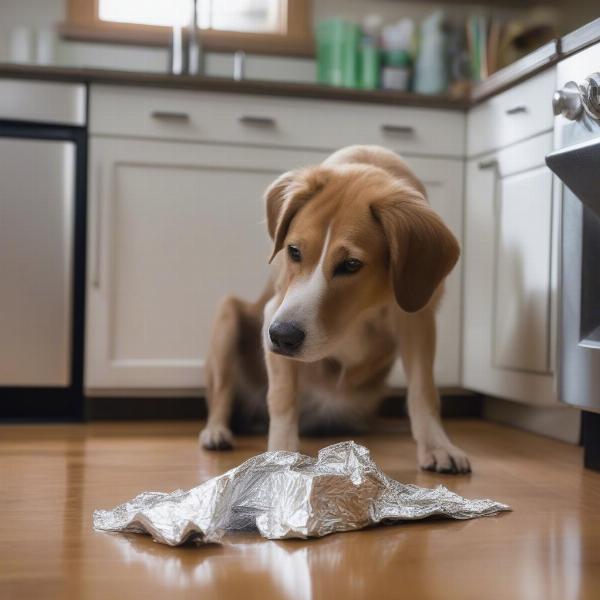If your dog ate foil, you’re likely feeling worried. This article addresses those concerns, providing practical advice and steps to take if your furry friend has ingested aluminum foil. We’ll cover the potential risks, signs to watch for, and when to seek immediate veterinary attention. Understanding what to do in this situation can help protect your dog’s health.
The Dangers of Foil Consumption in Dogs
While small amounts of foil might pass through a dog’s digestive system without incident, larger pieces or regular ingestion can pose serious health risks. Foil can cause blockages in the esophagus, stomach, or intestines, leading to vomiting, constipation, and abdominal pain. Sharp edges can also irritate or even puncture the digestive tract. Additionally, some dogs may experience aluminum toxicity, although this is less common.
 Dog eating foil in the kitchen
Dog eating foil in the kitchen
Signs Your Dog May Have Ingested Foil
If you suspect your dog ate foil, watch for these symptoms:
- Vomiting
- Loss of appetite
- Lethargy
- Abdominal pain or discomfort (whining, pacing, hunched posture)
- Constipation or difficulty defecating
- Changes in behavior, such as restlessness or aggression
What to Do if Your Dog Ate Foil
If you see your dog eat foil: Try to remove any remaining foil from their reach immediately.
If you suspect your dog ate foil but didn’t witness it: Assess the situation. If your dog is showing any of the signs mentioned above, especially vomiting or pain, contact your veterinarian immediately.
When to Seek Immediate Veterinary Attention:
- Your dog ate a large amount of foil.
- Your dog is showing signs of distress or illness.
- The foil was sharp or had jagged edges.
Do not induce vomiting unless instructed by your veterinarian. They will be able to assess the situation and recommend the appropriate course of action, which may include inducing vomiting, administering medication to protect the digestive tract, or even surgery in severe cases.
Preventing Foil Ingestion
The best way to manage this risk is prevention. Keep foil and foil-wrapped food items out of your dog’s reach. Ensure trash cans are secure and consider using child-proof latches on cabinets where you store these items. Train your dog to “leave it” or “drop it” to prevent them from picking up potentially dangerous items.
What if my dog ate a small piece of foil?
Small pieces of foil might pass through without issue, but monitoring is crucial. Look for any changes in behavior or digestion.
Can foil cause aluminum toxicity in dogs?
While less common than blockages, aluminum toxicity is possible, especially with repeated ingestion.
How can I tell if my dog has a blockage?
Symptoms like vomiting, constipation, and abdominal pain can indicate a blockage. Consult your veterinarian immediately.
Conclusion
Discovering your dog ate foil can be frightening, but swift action and veterinary guidance can significantly improve the outcome. Be vigilant in preventing access to foil and always err on the side of caution when it comes to your dog’s health. Contact your veterinarian if you have any concerns about your dog’s well-being. If you’re looking for more information on dog health and behavior, check out our articles on dog ate foil wrapper and my dog ate tin foil.
-
How long does it take for foil to pass through a dog? It can vary depending on the size of the foil and the dog’s digestive system, but it can take several days.
-
Can I induce vomiting at home if my dog ate foil? No, consult your veterinarian first. Inducing vomiting incorrectly can be harmful.
-
What should I feed my dog after they ate foil? Follow your veterinarian’s instructions. They may recommend a bland diet or withholding food initially.
-
Is all foil equally dangerous for dogs? While all foil poses a risk, sharp or jagged edges are particularly dangerous.
-
Can foil cause long-term health problems in dogs? If a blockage or perforation occurs and isn’t treated promptly, it can lead to serious complications.
-
What other household items are dangerous for dogs? Many items, including chocolate, grapes, onions, and certain medications, are toxic to dogs.
-
How can I prevent my dog from eating things they shouldn’t? Training, supervision, and securing hazardous items are key to prevention.
ILM Dog is your trusted international resource for expert dog care advice. We offer comprehensive information on breed selection, health, training, nutrition, grooming, and much more. From puppy care to senior dog support, we are dedicated to helping you provide the best possible care for your canine companion. For personalized advice or to explore our services related to dog health, nutrition, and training, please contact us at contact@ilmdog.com or +44 20-3965-8624. Visit ILM Dog today for all your dog care needs!